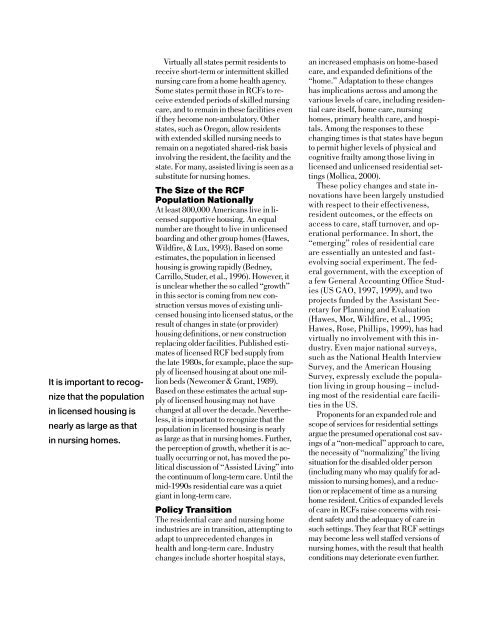UCSF School of Nursing - UCSF - University of California, San ...
UCSF School of Nursing - UCSF - University of California, San ...
UCSF School of Nursing - UCSF - University of California, San ...
You also want an ePaper? Increase the reach of your titles
YUMPU automatically turns print PDFs into web optimized ePapers that Google loves.
It is important to recognize<br />
that the population<br />
in licensed housing is<br />
nearly as large as that<br />
in nursing homes.<br />
Virtually all states permit residents to<br />
receive short-term or intermittent skilled<br />
nursing care from a home health agency.<br />
Some states permit those in RCFs to receive<br />
extended periods <strong>of</strong> skilled nursing<br />
care, and to remain in these facilities even<br />
if they become non-ambulatory. Other<br />
states, such as Oregon, allow residents<br />
with extended skilled nursing needs to<br />
remain on a negotiated shared-risk basis<br />
involving the resident, the facility and the<br />
state. For many, assisted living is seen as a<br />
substitute for nursing homes.<br />
The Size <strong>of</strong> the RCF<br />
Population Nationally<br />
At least 800,000 Americans live in licensed<br />
supportive housing. An equal<br />
number are thought to live in unlicensed<br />
boarding and other group homes (Hawes,<br />
Wildfire, & Lux, 1993). Based on some<br />
estimates, the population in licensed<br />
housing is growing rapidly (Bedney,<br />
Carrillo, Studer, et al., 1996). However, it<br />
is unclear whether the so called “growth”<br />
in this sector is coming from new construction<br />
versus moves <strong>of</strong> existing unlicensed<br />
housing into licensed status, or the<br />
result <strong>of</strong> changes in state (or provider)<br />
housing definitions, or new construction<br />
replacing older facilities. Published estimates<br />
<strong>of</strong> licensed RCF bed supply from<br />
the late 1980s, for example, place the supply<br />
<strong>of</strong> licensed housing at about one million<br />
beds (Newcomer & Grant, 1989).<br />
Based on these estimates the actual supply<br />
<strong>of</strong> licensed housing may not have<br />
changed at all over the decade. Nevertheless,<br />
it is important to recognize that the<br />
population in licensed housing is nearly<br />
as large as that in nursing homes. Further,<br />
the perception <strong>of</strong> growth, whether it is actually<br />
occurring or not, has moved the political<br />
discussion <strong>of</strong> “Assisted Living” into<br />
the continuum <strong>of</strong> long-term care. Until the<br />
mid-1990s residential care was a quiet<br />
giant in long-term care.<br />
Policy Transition<br />
The residential care and nursing home<br />
industries are in transition, attempting to<br />
adapt to unprecedented changes in<br />
health and long-term care. Industry<br />
changes include shorter hospital stays,<br />
an increased emphasis on home-based<br />
care, and expanded definitions <strong>of</strong> the<br />
“home.” Adaptation to these changes<br />
has implications across and among the<br />
various levels <strong>of</strong> care, including residential<br />
care itself, home care, nursing<br />
homes, primary health care, and hospitals.<br />
Among the responses to these<br />
changing times is that states have begun<br />
to permit higher levels <strong>of</strong> physical and<br />
cognitive frailty among those living in<br />
licensed and unlicensed residential settings<br />
(Mollica, 2000).<br />
These policy changes and state innovations<br />
have been largely unstudied<br />
with respect to their effectiveness,<br />
resident outcomes, or the effects on<br />
access to care, staff turnover, and operational<br />
performance. In short, the<br />
“emerging” roles <strong>of</strong> residential care<br />
are essentially an untested and fastevolving<br />
social experiment. The federal<br />
government, with the exception <strong>of</strong><br />
a few General Accounting Office Studies<br />
(US GAO, 1997, 1999), and two<br />
projects funded by the Assistant Secretary<br />
for Planning and Evaluation<br />
(Hawes, Mor, Wildfire, et al., 1995;<br />
Hawes, Rose, Phillips, 1999), has had<br />
virtually no involvement with this industry.<br />
Even major national surveys,<br />
such as the National Health Interview<br />
Survey, and the American Housing<br />
Survey, expressly exclude the population<br />
living in group housing – including<br />
most <strong>of</strong> the residential care facilities<br />
in the US.<br />
Proponents for an expanded role and<br />
scope <strong>of</strong> services for residential settings<br />
argue the presumed operational cost savings<br />
<strong>of</strong> a “non-medical” approach to care,<br />
the necessity <strong>of</strong> “normalizing” the living<br />
situation for the disabled older person<br />
(including many who may qualify for admission<br />
to nursing homes), and a reduction<br />
or replacement <strong>of</strong> time as a nursing<br />
home resident. Critics <strong>of</strong> expanded levels<br />
<strong>of</strong> care in RCFs raise concerns with resident<br />
safety and the adequacy <strong>of</strong> care in<br />
such settings. They fear that RCF settings<br />
may become less well staffed versions <strong>of</strong><br />
nursing homes, with the result that health<br />
conditions may deteriorate even further.


